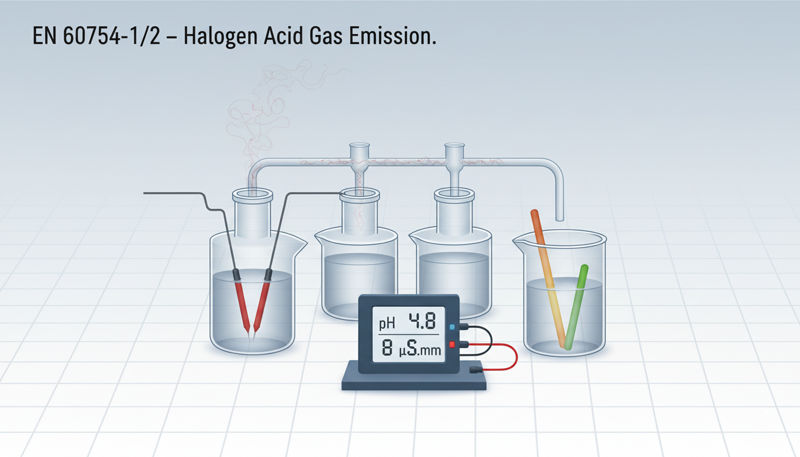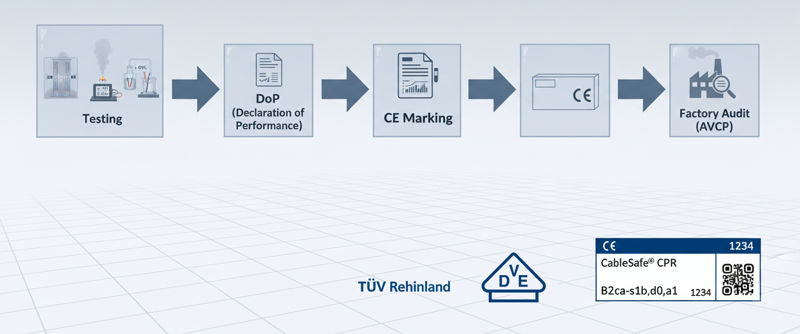Cable & Wire | High quality and excellent service at reasonable prices.
info@zion-communication.com
Author: Luke Publish Time: 22-10-2025 Origin: Site
In modern buildings, safety depends not only on the external structure but also on the critical infrastructure concealed within the walls. In the event of a fire, electrical and communication cables can propagate flames, generate toxic smoke, and release corrosive gases—all of which pose severe threats to human life and sensitive equipment. To mitigate these risks, the EU’s Construction Products Regulation (CPR) establishes unified fire performance standards for cables in permanent installations. The testing process—anchored by standards such as EN 50399, EN 61034, and EN 60754—ensures that every certified cable meets strict criteria for flame spread, smoke production, and acidity.
EN 50399 – Fire Propagation and Heat Release
EN 50399 is the cornerstone of CPR testing. It evaluates cable behavior under real-world fire conditions using a vertical flame spread test within a controlled chamber.
Key parameters measured:
Purpose: To classify the cable into Euroclasses (B2ca, Cca, Dca, Eca). For example, a B2ca cable demonstrates minimal flame spread and very low heat release, making it ideal for high-risk areas like hospitals or airports.
Flame spread height (FS)
Heat Release Rate (HRR) and Total Heat Released (THR)
Smoke Production Rate (SPR)
Falling droplets/particles

EN 61034 – Smoke Density Measurement
Even if a cable resists burning, smoke generation can still be a major hindrance to evacuation and a primary cause of asphyxiation. EN 61034 quantifies smoke density by measuring light transmittance through smoke generated during combustion.
Test conditions: Cable samples are burned inside a 3 m³ chamber while a photometric system measures light transparency.
Result interpretation:
This test defines the “s” parameter in Euroclass ratings (e.g., Cca-s1,d1,a1).
High transmittance (>60%) = Low smoke density (s1 classification).
Low transmittance (<20%) = High smoke density (s3 classification).

EN 60754 – Acidity and Corrosivity of Gases
When halogenated materials burn, they release hydrochloric and hydrobromic acids, which can corrode metals and cause catastrophic failure in electronic systems.
The standard consists of two parts:
Pass criteria for "a1": pH > 4.3 and Conductivity < 2.5 μS/mm.
Low acidity corresponds to the “a” parameter in CPR classification (e.g., a1 = low corrosivity).
EN 60754-1: Measures the quantity of halogen acid gas emission.
EN 60754-2: Measures the acidity (pH) and conductivity of combustion gases.

CPR testing requires highly controlled laboratory environments to ensure reproducibility:
Test Chamber: A sophisticated chamber simulating vertical cable runs on ladders with controlled airflow.
Calorimetry: Sensors tracking oxygen consumption to calculate the Heat Release Rate (HRR).
Optical Systems: Photometers for precise measurement of smoke transmittance.
Gas Analysis: Apparatus for collecting combustion gases to detect acidity and halogens.
Sample Consistency: Tests are repeated on standardized cable lengths (3.5m – 4.5m) with identical bundle arrangements to verify consistency.
CPR testing requires highly controlled laboratory setups:
Temperature-controlled flame chamber simulating cable bundles mounted vertically on ladders.
Airflow monitoring for consistent combustion.
Calorimeter sensors tracking oxygen consumption (for heat release rate).
Optical instruments measuring smoke transmittance.
Gas collection apparatus for acidity and halogen detection.
Sample requirements:
Standardized cable lengths (3.5–4.5 meters)
Identical bundle arrangement
Repetition to verify consistency
Under the CPR framework, official assessments must be performed by EU-recognized Notified Bodies (NB) such as TÜV, VDE, or Intertek.
Key responsibilities of the NB:
Independently conduct type testing (EN 50399/61034/60754).
Issue the official Classification Report and test data.
Audit the manufacturing process: For System 1+ compliance, NBs perform regular factory audits and random sample testing to ensure production remains consistent with the initial certified samples.
Manufacturer Obligations: Manufacturers must maintain traceable quality control systems, retain Declaration of Performance (DoP) records for 10 years, and apply CE markings with the correct Euroclass to all packaging.
Zion Communication employs a dual-layer strategy that combines rigorous in-house quality control with official third-party certification.
Internal Quality Steps:
Routine smoke density checks using EN 61034-equivalent small-scale chambers.
Acidity simulation tests to verify the purity of Halogen-Free (LSZH) compounds.
Vertical flame spread verification on finished cable batches.
External Certification:
Submission of samples to EU Notified Laboratories for full-scale EN testing.
AVCP System 1+ Certification: Continuous auditing by authorized inspectors to guarantee uncompromised quality.
Each product range (e.g., Fire Alarm, Data, or Power cables) receives a specific Euroclass rating (e.g., Cca-s1b,d1,a1) and a unique DoP number.

CPR testing—anchored by EN 50399, EN 61034, and EN 60754—is more than a regulatory requirement; it is a safeguard for human life and infrastructure. By strictly adhering to these standards and maintaining transparent, audited certification procedures, Zion Communication demonstrates its commitment to delivering safe, low-smoke, halogen-free cables that meet the highest expectations of the European market.
Contact us for more information

Luke Han is a Product Manager and Director at Zion Communication,
Specializing in fire, security, and alarm solutions. With extensive industry experience,
Dedicated to delivering high-performance, reliable products that are tailored to customer needs.
luke@zion-communication.com
0086 19883212162
